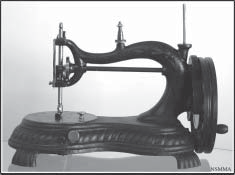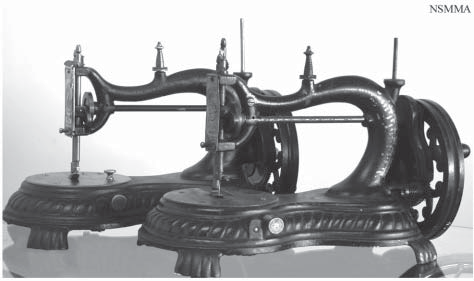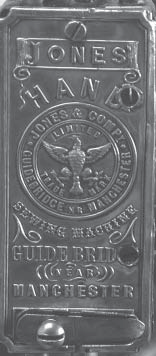1879 - The First Jones Hand
by Lee King, NSMMA
ISMACS News
Issue 82

fig 1
Every now and then luck or fate arrives at your door or in this particular case, the phone.
For the sake of privacy, I have promised to keep the identity and in particular the location of where I obtained this rare machine private. If I am ever in Ontario, Canada, I will stop by to see John and thank him in person anyway.
I had been buying sewing machines from a now great friend Mike Anderson in New Hampshire, USA. Mike, more commonly known to the world of eBay as Wolfegangs-Collectibles had passed on my phone number to a person he had met whilst on a trip through Canada. According to Mike, this person had several old sewing machines he had obtained from a deceased estate and wished to sell them. Of course, always being interested in old sewing machines I said I would love to know more about what he had for sale.
It was roughly a week later and very late at night that I received the call that I was not to forget. After brief introductions and pleasantries, it was down to business. What exactly do you want to sell; can you describe the machines for me?

fig 2
The first two machines didn't even bat my eyelids but the description of the third had placed a smile on my face that today still requires plastic surgery.
It took two seconds to understand that this third machine was in fact a Jones Hand as it said so on the needlebar cover! I have a great fondness for the early Jones Hand machines and asked several pertinent questions in order to determine just how early it was. The answers that came back had me scratching my head, I thought at this point the guy did not have the machine and was making the whole thing up, but why go to this length to sell a machine that did not exist?
A question I should have asked right from the start was what is the serial number?
On Jones Hand machines, also known as serpentine or cat back machines, the serial number can be found under the slide plate stamped into the cast housing. A simple question that confirmed either the guy could not see or this machine was something special.
Let me get my glasses, ok, here it is, 485. Are you sure there are no other numbers? 485, that is all there is. At this point plastic surgery is imminent!
Ok, I am interested but I will have to see pictures first before I say yes or no. 30 seconds later I had promised to send the money for this sight unseen machine and the rest is now history. I have on good authority, many thanks ~G.F~, been advised there are only two of these rare Jones Hand machines known to exist in the world today.
One is in a private Japanese collection and of course my own, here in the newly established NSMMA or National Sewing Machine Museum of Australia.
Let us look at some key points with this ~first~ Jones Hand machine.
I think most noticeable is the gadrooning that surrounds the entire base of the machine; this does not appear on any later model but it is replaced by a decal. Secondly is the cotton tension located in the center, at the top of the arm, again this does not appear on any later model. fig 1
This first model Jones Hand did not allow the balance wheel to be free spinning. The balance wheel has a square edge with no indentation for a treadle belt. fig 2 The brass needlebar cover is also unique to this machine in design. fig 3 These are but a few of the differences between this the first model and the more common ones found today.
Now the big question, who made this machine?
Why ask such a silly question?
Well let us compare it to the Kimball & Morton ~Stitch in Time~ serpentine machine of the same era! Yes, that's right a Kimball & Morton serpentine machine, wow!
This Kimball & Morton ~Stitch in Time~ serpentine machine can also be regarded as being rare, not quite at the level of the Jones but, rare nontheless. Put the two together and''..Snap! fig 4

fig 4
With the exception of a different brass needlebar cover, these two machines are virtually identical. Compare fig 3 and 5.

fig 3

fig 5
I say virtually because there is an improvement to the casting of the Kimball & Morton needlebar support. The casting has been made thicker for strength as this must have been an initial problem to be adjusted so early in the design.
The introduction of a bar to restrain the shuttle in its carriage has also been added to the Kimball & Morton machine.
The pictured Kimball & Morton ~Stitch in Time~ serpentine has a serial number of 877. How long these serpentine machines were offered for sale by the Kimball & Morton Company is not known. What is known is that the Jones Company continued successfully with the basis of the serpentine design for many years.
So now you know why I ask, who really did make the ~First~ Jones Hand?





